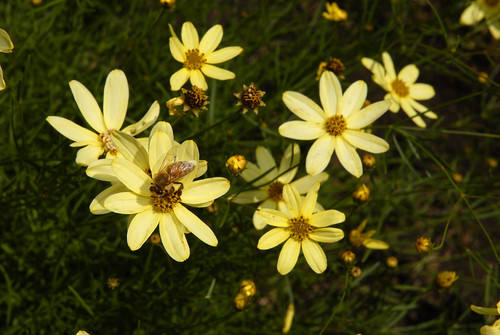Tantalizing Tickseeds
Posted in Gardening Tips on August 30 2011, by Sonia Uyterhoeven
 |
Sonia Uyterhoeven is Gardener for Public Education. |

After several spates of sizzling summer weather, many gardeners were left looking for drought tolerant alternatives to lush perennial garden plantings. One perennial that has been a stalwart of my garden has been tickseeds or coreopsis.
The odd common name of tickseed comes from the fact that people used to think the seed head looked like a tick. There are a number of species of tickseed but one of the most popular and drought tolerant species is the thread-leaf tickseed, Coreopsis verticillata.
Tickseeds are in the Asteraceae family. They tend to form 1-2 foot mounds that are covered with daisy-like flowers. They are tough customers that don’t shy away from the summer heat and have the added bonus of being deer resistant. Many cultivars flower from June through September–and sometimes into October–and are known for their flower power.
The Home Gardening Center features a number of cultivars which include a few winners in the world of coreopsis. One of my favorites is ‘Route 66’. It is an interesting alternative to your predominately yellow tickseeds. This cultivar has a red eye that bleeds into the yellow petals to produce a brilliant contrast.
It is not simply the contrast and colors that appeal to me with this cultivar, it is also one of the few tickseeds that remain upright and hold its shape throughout the season. I have to tell you we grow these perennials in a fairly heavy soil (clay loam) that we are constantly amending and trying to improve. Tickseeds would have a better chance of retaining their form and not flopping over in a leaner soil.
Another tried and true cultivar that we grow is ‘Crème Brulee™’. ‘Crème Brulee™’ is the improved version of ‘Moonbeam’. I am still a great admirer of ‘Moonbeam’ so don’t rush to rip it out. The newer cultivar is a natural mutation that has slightly deeper butter-yellow flowers. It is still pale as yellows go; like its predecessor it is covered in a sea of flowers.
This cultivar flops in our garden and the antidote is to wait until it finishes its first major flush of flowers and then sheer it back – just like you do with your catmint (Nepeta). The foliage will fill back in to a nice round form and it will re-flower (although not as vigorously).
A final cultivar that is worth mentioning is an introduction from Sunny Border Nurseries in Connecticut. It is called ‘Sienna Sunset’ and as the name suggests is a lovely burnt sienna color. ‘Crème Brulee’ is one of its parents so it is endowed with good flowering and the butterflies love it. I think you will like this cultivar too – its color is a refreshing change from traditional yellow. It also flops in our rich soil, but this would probably be remedied in a leaner growing environment.

